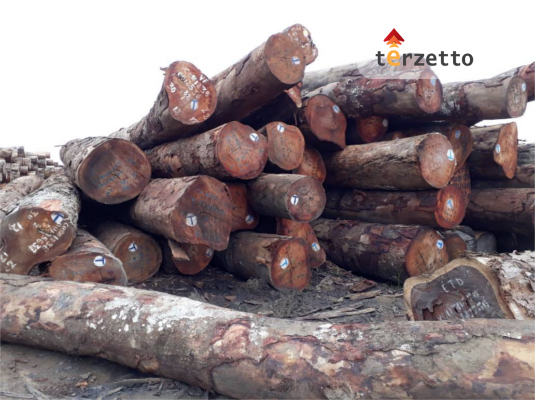
TRADE NAME: Tali
SCIENTIFIC NAME: Erythrophleum suaveolens Brenan
- BOTANICAL DESCRIPTION: The tree is up to 30 to 45 in height, with a bole length of 10 to 16 m, usually irregular, often buttressed. The trunk diameter attains 100 to 150 cm.
- NATURAL HABITAT: Erythrophleum suaveolens occurs in moist forests, dense dry forests and along riverbanks.
- NATURAL DISTRIBUTION: West, Central and East Africa, mainly in Guinea, Central African Republic and Democratic Republic of the Congo.
- COLOR: The sapwood is yellowish white to pinkish white, it has a thickness of 3 to 6 cm. The heartwood is yellow-brown to red brown, darkening on exposure, it is clearly demarcated.
GENERAL WOOD DESCRIPTION
- GRAIN : The grain is highly and systematically interlocked; special care is needed when drying because of frequent risks of distortion.
- TEXTURE : The texture of the wood is frequently coarse.
- NATURAL DURABILITY : Very durable to decay; without preservative treatment. This species is especially suited for all the uses with risks of permanent or long-lasting humidification. Resistant to termites attack. Heartwood is resistant to Lyctus attacks.
- NATURAL DURABILITY INDEX (1= VERY HIGH DURABILITY,7=VERY LOW DURABILITY) 1
- INTERNAL GROWTH STRESSES : No residual stresses are reported in this species.
- SILICA CONTENT : Negligible content of silica is reported. Amounts over0.050/s may affect wood processing. Silica Value: 0.01
- RESISTANCE TO IMPREGNATION : Nearly impossible to treat with a too much low penetration of the preservative substances.
WOOD PHYSICAL PROPERTIES
BASIC DENSITY OR SPECIFIC GRAVITY (O.D. WEIGHT/VOL. GREEN) (G/CM°) 0.83 AIR-DRY DENSITY (WEIGHT AND VOLUME AT 120/oM ) (G/CM°)0.96
TOTAL SHRINKAGE TANGENTIAL (SATURATED TO 00/oM ) (0/o)10.5 TOTAL SHRINKAGE RADIAL (SATURATED TO 00/oM ) (0/o)5.7 DRYING DEFECTS
- Ease of Drying: Drying is slow but without difficulties.
- Drying Defects: No particular risks of drying defects, subject to normal drying conditions.
- Kiln Schedules: The kiln sched-ule has been tested.
- RECOMMENDED DRY KILN SCHEDULE FR-13 DIMENSIONAL STABILITY RATIO (TOTAL TANGENTIAL SHRINKAGE 0/o/TOTAL RADIAL SHRINKAGE 0/o) 1.8
WOOD MECHANICAL PROPERTIES
BENDING STRENGTH (MOR),12 0/oM (KGF/CM2 ) 1181 STIFFNESS (MOE) 120/oM (KGF/CM2 ) 133923 COMPRESSION PARALLEL TO FIBER 120/oM (KGF/CM2 ) 801
COMPRESSION PERPENDICULAR TO FIBER 120/oM (KGF/CM 2 ) 116 SHEAR STRENGTH RADIAL 120/oM (KGF/CM 2 ) 88 JANKAHARDNESS (SIDE) 120/oM (KGF) 1148
JANKAHARDNESS (END GRAIN) 120/oM (KGF) 1167
WORKABILITY
- SAWING: Sawing of this species requires powerful equipment.
- ROTARY VENEER CUTTING: Not suitable for veneering. SLICED VENEER : Not suitable for veneering.
- BLUNTING EFFECT: Moderate blunting effect; stellited blades for sawing and carbide tools for machining are advised.
- MACHINING: It needs powerful tools for processing. Possible difficulties caused by interlocked grain are reported. It is recommended to use special tools for cutting.
- PLANING: Rather difficult; special tools are needed.
- MOULDING: Moderately easy; tools must be cautiously sharpened. BORING: Moderately easy; tools must be cautiously sharpened.
- MORTISING: Moderately easy; tools must be cautiously sharpened. NAILING : Pre-boring is necessary.
- GLUING: Difficult to glue because of high density.
- SANDING: Difficult to obtain very good results because of interlocked grain. POLISHING : Needs pre-coating.
- RESPONSE TO HAND TOOLS: Working with hand tools is difficult.
END USES:
EXTERIOR GENERAL, bridges, poles, paling, stakes posts, crossarms, crossties, piers, HOUSING GENERAL, beams, joists, boards, flooring, parquet, frames,CONTAINERS, truck bodies, truck flooring
